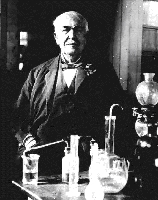 |
| Trademarks: Fingerprints of Commerce USPTO Museum |
Thomas Alva Edison lived from 1847 to 1931, he was an American inventor, and he is considered one of the greatest inventors of all time. He began his work early in life and continued to work until he died. During his career as an inventor, he was well known for his focus and determination. By the end of his career Edison had patented more than 1,000 inventions, which included the electric light, the phonograph, and the motion-picture camera. These inventions gave birth to three giant industries—electric utilities, phonograph and record companies, and the film industry. The period from 1879 to 1900, when Edison built, tested, and fine-tuned most of his inventions, has been called the Age of Edison.
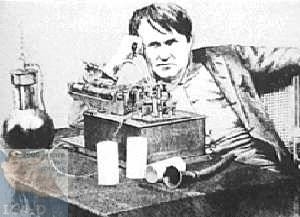 |
| The Library of Congress |
Edison's first major achievement at Menlo Park was an improvement on the telephone. The telephone that Alexander Graham Bell invented in 1876 could not operate over distances of more than 3 to 5 km (2 to 3 mi). After hundreds of experiments, Edison improved the telephone to such an extent that it could carry speech clearly over almost unlimited distances. In March 1878, Edison's telephone system connected New York City to Philadelphia, Pennsylvania, a distance of 172 km (107 mi).
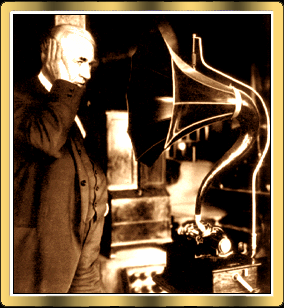 |
| Jones Telecommunications and Multimedia Encyclopedia (all rights reserved) |
While working on the telephone, Edison also worked on perhaps his most original invention. He had noticed how the phone’s diaphragm, a thin membrane in the mouthpiece, vibrated in tune with the voice. He thought that if these vibrations could somehow be recorded, so that the diaphragm could be made to vibrate in exactly the same manner at any future time, then speech, music, and other sounds could be preserved and reproduced. Edison tested the strength of the diaphragm vibrations by holding a needle against the diaphragm with his finger, so that the needle pricked his finger with a force that varied with the loudness of the sounds. In a later experiment, he applied one end of the needle to the diaphragm and the other end to a strip of waxed paper. He then pulled the paper along underneath the needle while repeatedly shouting, "Hello!" The needle, activated by the vibrations of the diaphragm, created grooves in the paper. When the paper was again pulled along underneath the needle, the needle followed the grooves it had formed earlier and pushed against the diaphragm, making the diaphragm reproduce Edison's shouts. This first crude experiment, performed in 1877, marked the beginning of the phonograph. Edison obtained a patent on the phonograph in February 1878. By this time he had replaced the waxed paper with metal cylinders covered with tinfoil. He postponed further development of the phonograph, however, for some years.
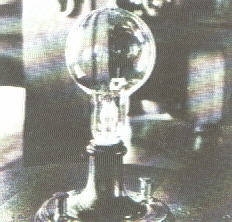 |
After patenting the phonograph, Edison set out to develop an incandescent lamp, which would produce light by heating a wire until it glowed brightly. People already used electric arc lights, which produced light by creating an arc of electricity between two wires. However, the blinding glare these arc lights gave off made them unsuitable for home use. Edison, like others before him, conceived the idea of a light with a glowing wire, or filament, made of a substance that could endure very high temperatures without fusing, melting, or burning out. After hundreds of trials and more than a year of steady work, Edison developed a high-resistance carbon-thread filament that burned steadily for more than 40 hours. Although not the first incandescent electric light, it was the first practical one because it used a small current and, in addition, lasted a long time without burning out.
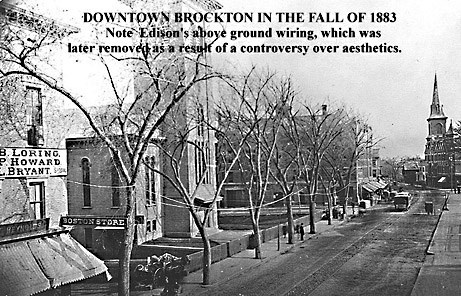 |
Edison realized that widespread use of electric light bulbs would require an efficient system of delivering electricity to homes and businesses. He developed detailed plans for an entire distribution system for electric power. This system included generating the current by means of a central dynamo (device that turns mechanical energy into electricity) and then distributing it in small quantities to thousands of homes and commercial buildings. Edison even developed a greatly improved dynamo to reduce the cost of generating electricity. The system Edison suggested in 1879 included the parallel circuits, safety fuses, insulating materials, and copper-wire networks used in modern electrical systems. By 1881 Edison had set up a complete electric lighting system at his Menlo Park home. That same year his system took top honors at the Paris Electrical Exhibition in France. In 1882 at Holborn Viaduct in London, the Edison Electric Lighting Company completed and began operating the first commercial generating station for incandescent lighting in the world. This installation used an underground main and feeder circuit to supply power for 2,000 lamps. Later in 1882 Edison established the first permanent incandescent light and power station for private consumers, called the Pearl Street generating station, in New York City. When Edison died, the U.S. government considered turning off all electric current in the country for a minute or two as a tribute to him. It became apparent, however, that the operation of the great electrical distribution systems of the nation could not be interrupted even for a moment without possibly disastrous effects. Within Edison’s lifetime, the system that he had pioneered had become essential to the nation's way of life.
Page created on 2/4/2003 12:00:00 AM
Last edited 2/4/2003 12:00:00 AM
